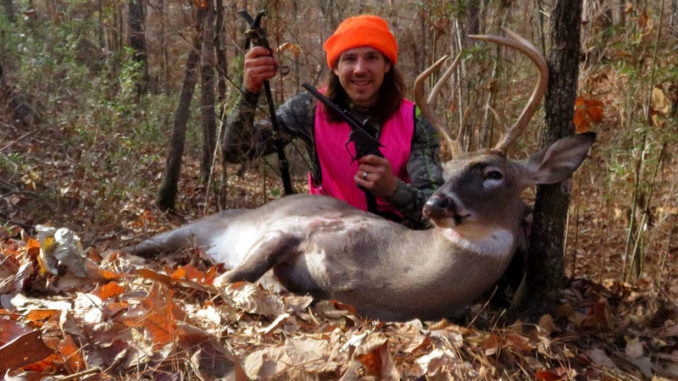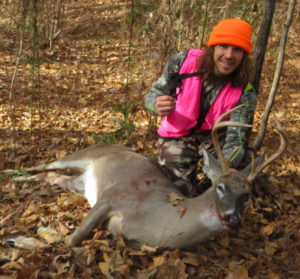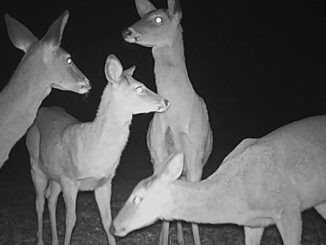
Acorns from red and white oaks are the key
Years ago, I ventured alone into the public lands of Louisiana hill country. With my only hunting experiences coming from river bottom flatlands, I had no clue how the deer moved throughout these steep areas. And even though I wasn’t having any success, the hills offered such beautiful scenery and challenging terrain that I kept coming back for more.
The deer would often skip quickly along the hills at a pace unlike anything I had ever seen before – it’s like they were constantly running. Being that I enjoy using my traditional bows or a primitive pistol, I had to figure out where these hill goats would stay put for a minute or two. Soon I found out what they were running toward – just a few specific oak trees.
Still, I rarely saw deer, except when I wasn’t there on my cameras. Often I would hear them angrily blowing at me from behind. And even though I finally found which hill oaks to hunt by, more importantly, I had to figure out how to get there without the deer knowing it.
I found the deer would often work one direction in the mornings, and approach from the opposite direction in the evenings. Cameras and endless hours in the stand showed patterns with undeniable statistics. So with a new strategy, soon I was seeing deer on most hunts, and shooting deer with my recurve and pistol yearly.
They have several different oak varieties in the North Louisiana hills, but I have the most luck focusing on the white oaks in November, and the red oaks in December.
But what I don’t do is take the easiest paths to these trees.
I like to approach by hooking around the wind and climbing up and over several hills. Usually my spot is less than a mile walk from the road, but my strategy takes me twice as far with many extra climbs to reach my location. Last December I harvested two bucks with my 44 mag primitive pistol while hunting my favorite hilltops where deer were feeding on the small acorns of southern red oaks.
On my favorite hunt, the west wind was wrong for my usually long approach to this saddle where two hills converged. So I left my stand on the ground hoping for an east wind that never came during my hunting vacation. I took my other heavy climber and carried all my gear up a bottom several hills away, then went over several hills taking an even longer way — a two-hour grueling ordeal just to set up with my more comfortable climber that was a stone’s throw away.
The move paid off. Soon I was watching a spike chase three does that kept trying to feed on the red oaks in between my unused climber and me. They had approached from the northwest as expected, walking just feet from the unused stand.
The young buck chased the hungry does in circles within 20 yards of me for over an hour. Eventually the aggravated does fought back and ran the buck off to the west. They kept feeding a while before bedding down just 30 yards in some reeds near the feed tree. The buck came back two more times and eventually left.

Finally, around 11a.m., while watching the does sleep, my hearing enhancers picked up a subtle noise coming from a steep gully to the southwest. That gave me just enough time to turn and adjust my pistol on the monopod. It was a tall 6-point moving quickly in my direction. (I had seen this buck out of pistol range on several previous hunts.)
The buck passed just under the same few red oaks the does fed at. That’s when it slowed down to sniff around, and was finally close enough where my non-magnified micro red dot could line up the vitals. However, with my buck fever inducing shaking and the strong kick of the ultra-light 3-pound Contender handgun, the monopod fell out the stand after the shot and I nearly dropped the pistol, too.
Luckily, the copper expander bullet flew true with the help of my monopod triggerstick. All of that hard work of humping over hills to have the correct wind under the correct oaks gave me the most satisfying feeling as I grasped those horns.
If I had lazily hunted my other climber, I most likely wouldn’t have seen a single deer on that hunt, and would have probably just heard angry deer blowing at me from downwind like year’s past.
I didn’t hunt the hills this November, but in previous years I’ve had success hunting the white oak acorn trees located on the side of the hills. It’s the biggest trees that often produce the most deer activity. I look for larger trees where most of the leaves are pawed away, exposing mostly a dirt and chewed-shell forest floor.
The white oak bark is scaly and ridged, and is bright silver to light grey in color. The leaves are multi-lobed and rounded. The acorns are large, long and brown to light brown in color, and fall quickly in large quantities. They have softer shells and more carbohydrates, giving a sweeter taste.
During these November hunts, I focus on the white oaks on steeper hillsides toward the middle of the hill. I hike down to the center of the bottom with the wind in my face. Then, I climb really high in a tree to get the best views of both sides. I’ll climb over 50 feet in some of the 100-plus-foot trees. This puts me in bow or pistol range to the hill on each side of me. Still, the deer are often above me when I see them, so making little movement is imperative.
Once December arrives, I’ll sometimes see deer still searching for the few remaining white oak acorns near a hot tree. However, that’s when the deer switch food sources and head to higher ground.
It’s the southern red oaks the winter deer are feeding under. The acorns from shorter, smaller trees growing at and near the tops of hills usually attract the most deer.
The southern red oak has smoother bark that’s mostly dark grey and dark brown. The leaves are long and thin, and have pointy tips on the lobes. The acorns are small, circular and brown with micro dots, forming little lines down the shells. These acorns have more tannins and proteins, and are bitter to the taste.
The southern red oak acorns don’t fall as plentiful or as quickly as the white oaks, so it takes a more careful inspection under the tree to find out if it’s really being used often. Some trees that barely look disturbed could have deer visiting multiple times a day to feast.
To hunt these hilltop red oaks, I hike up high myself. I like to find a nice saddle or connection of hill fingers to set up where a few southern red oaks are falling. Unlike the hill bottom white oak strategy, I don’t have to climb high in the tree at all to get great views from these hilltops.
In the hills, the deer love bedding in thick reeded areas near steep gullies and ledges where they feel safe with great views. Usually I see the deer get up from their beds close to the oaks, so it’s important to have a good game plan on getting set up without spooking them. I like to approach from a non-steep hillside with less vegetation, leaving anything hiding in the thicker reeds on the opposite side unaware of my presence.
This December, I finally made my way back to the hill country, leaving the hogs in the flatlands alone for a few weeks. I set up in a spot where last year I had rattled in a buck to 10 yards just before dark one evening. I’ll never forget that buck sprinting down and back up the hill, and stopping less than 20 yards away in reeds where I couldn’t see it in the low light with my pistol’s red dot.
Sure enough on this first hunt, I had a 6-point smaller than last year’s buck come right to me. On this first encounter, the 6-pointer followed my drag rag to just 8 yards from my tree and looked right at me for a while. I held off, hoping for some much bigger bucks I had on camera, and just filmed the buck.
The next day it came back and was looking right at me from 40 yards away, but it still fed under the red oaks next to a smaller 4-pointer. The buck was looking at me after every mouthful of acorns when it picked its head up to chew, but I guess it was too hungry to care about me being there.
The next week it passed by again, but was too preoccupied finding a hot doe to feed, but it still he give me another long stare as it passed by. Next year when it’s bigger, I’ll have to set up in a different tree to fool it.
Unfortunately, the large bucks I was after came out under my feed trees on camera on the days I was at work back home. Still, I saw deer on most of my hunts there. I finally saw a nice buck with a doe in late December, but they never came in range.
With the rut basically over in that area, I’m now off to hunt different food sources during the January rut of the Mississippi bottom hardwoods. But it was nice to see deer pattern just as I expected, and feed under the scouted oak trees after making those long hikes. Figuring out the deer with a hard-learned game plan can be just as satisfying as the harvest.

